Overview
A monolith application represents a unified software system where all components—user interface, business logic, and data access—are seamlessly integrated into a single codebase. This integration simplifies both development and deployment, particularly for smaller projects. However, as these applications expand, they encounter significant challenges related to scalability and complexity. This scenario has prompted a noticeable shift towards modular monoliths and microservices, which offer enhanced flexibility and adaptability in response to evolving business needs.
Furthermore, consider the implications of remaining with a monolithic structure as your project scales. Are you prepared to face the limitations that could hinder your growth? Embracing modular approaches not only addresses these challenges but also positions your organization to respond effectively to market demands. As a result, transitioning to a more adaptable architecture could be the key to sustaining your competitive edge in a rapidly changing landscape.
Introduction
In the ever-evolving landscape of software development, the debate between monolithic and microservices architectures is intensifying. Monolithic applications, with their single, cohesive structure, provide simplicity and rapid deployment, making them particularly appealing for startups and smaller projects.
However, as organizations expand and their needs grow more complex, the limitations of monolithic systems—such as scalability challenges and slower development cycles—become increasingly evident. Meanwhile, the emergence of microservices offers enhanced flexibility and independent scaling, presenting a compelling alternative.
This article explores the intricacies of monolithic applications, examining their advantages and disadvantages, while also highlighting the ongoing transition toward more modular architectures. Furthermore, it emphasizes the role of innovative integration solutions like Avato in navigating these architectural shifts.
Understanding these dynamics is crucial for businesses seeking to modernize their operations and maintain a competitive edge in a rapidly changing digital environment.
Defining Monolithic Applications: An Overview
A monolithic system exemplifies what constitutes a monolith application, characterized by the unification of all components into a single cohesive unit. This design integrates the user interface, business logic, and data access layers within one codebase, streamlining the development process. Monolithic systems are particularly advantageous for smaller projects due to their simplicity in development and deployment, requiring minimal initial planning and enabling rapid construction.
However, as these systems expand, they often become increasingly complex, leading to significant challenges in management and scalability. This raises the pertinent question: what is a monolith application? Recent trends indicate that while many companies continue to employ unified structures, there is a noticeable shift towards microservices, which facilitate continuous delivery and updates without disrupting the entire system. By 2025, approximately 60% of businesses are projected to still rely on unified structures, underscoring their enduring role in the software landscape.
Real-world examples of unified systems can be found across various sectors, including banking and healthcare, where legacy systems often dominate. Although functional, these tools can impede innovation and responsiveness to market dynamics. Experts suggest that while unified structures, essentially what is a monolith application, provide a solid foundation, they may ultimately constrain an organization’s flexibility.
Statistics reveal that 75% of organizations employing unified software face challenges in scaling and integrating new technologies.
Conversely, modern integration solutions, such as those offered by Avato, emphasize the importance of reliability in software architecture. Founded by a team of dedicated enterprise architects, Avato is committed to addressing complex integration challenges. The name ‘Avato’ reflects this commitment, derived from the Hungarian word for ‘of dedication.’
Avato’s hybrid integration platform accelerates secure system integration for critical sectors like banking and healthcare, ensuring 24/7 uptime for essential integrations. This reliability is vital for maintaining operational continuity and enhancing customer satisfaction. A notable instance of Avato’s impact is its collaboration with Coast Capital, where the solution went live in February 2013, facilitating major system transitions with minimal downtime—only a 63-second outage during a significant switch in June 2016.
Additionally, Gustavo Estrada, a customer, remarked that Avato simplifies complex projects and delivers results within desired time frames and budget constraints, highlighting the advantages of effective integration solutions.
As businesses increasingly pursue modernization, understanding the implications of unified architecture becomes imperative. The ongoing evolution in software development underscores the necessity for organizations to carefully evaluate their architectural choices, balancing the benefits of simplicity with the demands of scalability and flexibility. The shift towards microservices not only supports continuous delivery but also enhances overall performance, reinforcing the movement away from large-scale systems.
Avato’s expertise in hybrid integration positions it as a pivotal player in transforming legacy systems, delivering cost-effective solutions that empower businesses to future-proof their operations.
Key Characteristics of Monolithic Architecture
Monolithic architecture is characterized by several distinct features that shape its functionality and management:
-
Single Codebase: All components reside within a single codebase, simplifying management and streamlining development processes. This unified structure allows developers to work within a cohesive environment, exemplifying a monolith application and reducing the complexity often associated with multiple codebases.
-
Tightly Coupled Components: In a unified system, components are tightly connected, meaning that a change in one area can have cascading effects on others. This interdependence complicates maintenance and updates, as developers must consider the entire system when making modifications.
-
Unified Deployment: The deployment of a single cohesive system occurs as a single unit. While this approach simplifies the deployment process, it can pose challenges when scaling and updating specific features without affecting the entire system. This characteristic is particularly relevant in environments where uptime is critical, as any deployment issues can lead to significant downtime. Avato ensures 24/7 uptime for critical integrations, highlighting the importance of reliability in regulated sectors like banking, healthcare, and government.
-
Simplicity: For small to medium-sized systems, unified architecture can be straightforward and efficient. It allows for rapid development cycles, making it an attractive option for startups and projects with limited scope. However, as applications grow, this simplicity can become a double-edged sword, leading to increased complexity in management and scalability.
Recent insights from software architects emphasize the significance of comprehending these traits when overseeing a unified codebase. Mike Tria, Head of Platform at Atlassian, noted, “I spent more time making sure that our SRE team was successful in this project than almost any other work that I did during the project because the cultural shift was the biggest long-term difference for Atlassian as a result of Vertigo.” This highlights the management difficulties linked with unified structures.
Statistics suggest that organizations utilizing unified structures often encounter quicker time-to-market for smaller projects but may face higher operational expenses and network delays as they progress. In contrast, microservices allow for easier adoption of new technologies but come with higher operational costs and potential network latency.
In summary, while unified architecture, which relates to what is a monolith application, offers several advantages including ease of management and rapid development, it also presents challenges that must be carefully navigated, particularly in larger, more complex systems. Avato’s Hybrid Integration Platform tackles these challenges by streamlining the integration of disconnected legacy systems and fragmented data, offering speed, security, and ease in integration, which is essential for effective management of large-scale systems. Additionally, Avato’s platform features real-time monitoring and alerts on system performance, enhancing operational oversight.
Furthermore, adopting a phased implementation strategy with Avato’s platform minimizes risks and enhances adaptability, ensuring a smooth transition and maximizing the value of legacy systems while significantly reducing costs.
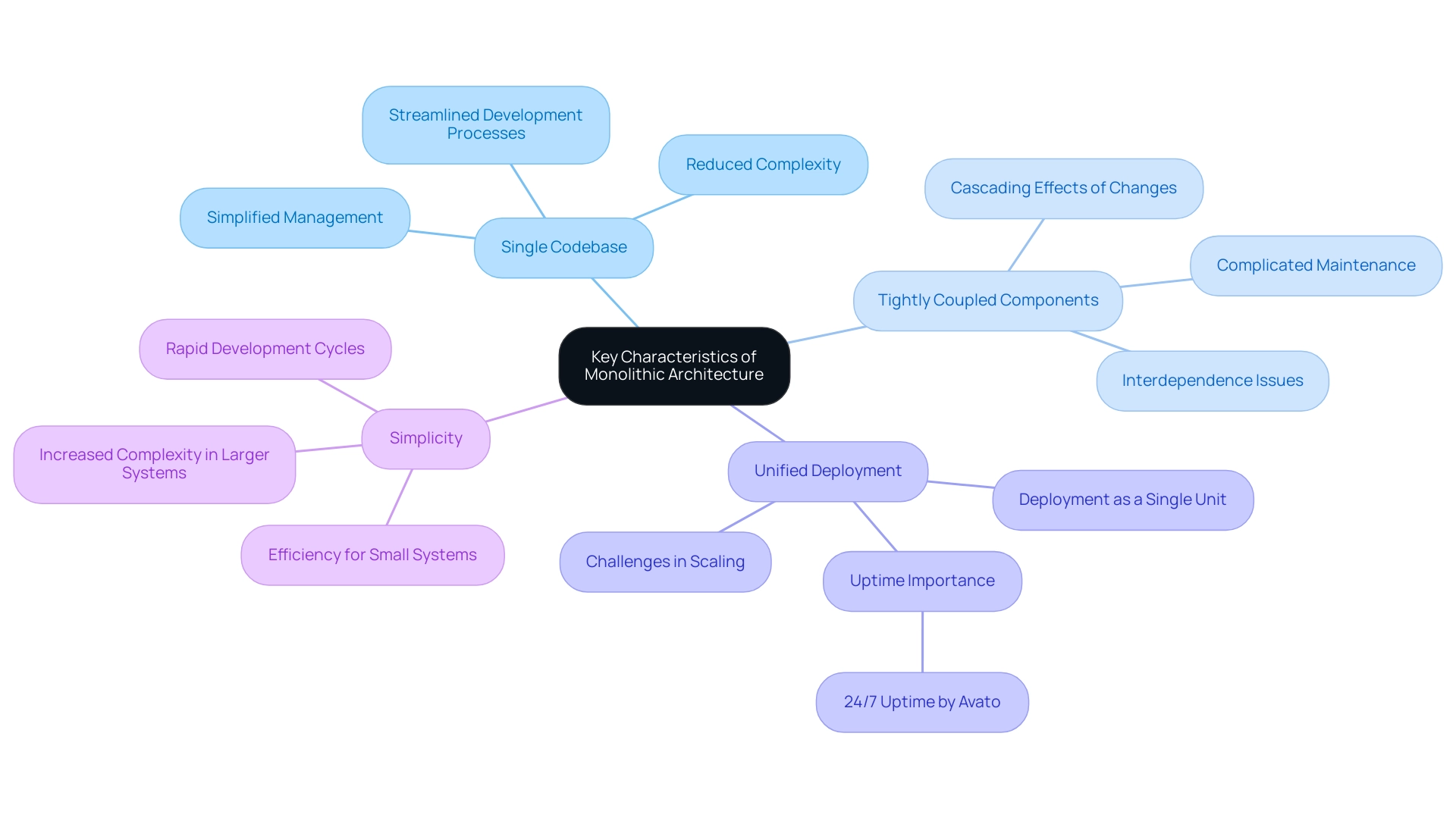
Advantages of Monolithic Applications: Why Choose This Approach?
Monolithic applications present a range of compelling advantages that make them particularly appealing for startups and smaller enterprises.
- Faster Development: The integrated codebase of large-scale systems enables developers to swiftly create and launch solutions. This speed is crucial for startups aiming to launch Minimum Viable Products (MVPs) quickly, allowing them to test their ideas in the market without extensive delays. Mike Tria, Head of Platform at Atlassian, emphasizes that aligning with core values prioritizing customer satisfaction can be achieved through efficient development processes, which unified structures facilitate.
- Simplified Testing: With all components combined into a single program, testing becomes more straightforward. This integration facilitates easier identification of bugs and issues, streamlining the quality assurance process and reducing the time spent on debugging.
- Lower Initial Costs: The intrinsic straightforwardness of a unified structure often results in decreased development expenses. For smaller businesses, this cost-effectiveness is a significant advantage, allowing them to allocate resources more efficiently during the critical early stages of development.
- Easier Debugging: Monolithic applications centralize all functionalities, simplifying the debugging process. Developers can track down issues more efficiently compared to distributed systems, where problems may arise from multiple interacting components.
- Expert Insights: Industry specialists have observed that unified structures can greatly improve development speed. For instance, Mike Tria highlights the importance of aligning with core values that prioritize customer satisfaction, achievable through efficient development processes.
- Real-World Examples: Companies that have employed unified structures have reported quicker development cycles, especially in their early stages. This approach enables startups to concentrate on enhancing their product offerings without the complications introduced by distributed services. Notably, Amazon originally employed a unified structure before transitioning to service-oriented design for improved scalability and adaptability, demonstrating the practical effects of this structural decision.
- Statistics on Testing Efficiency: Recent studies suggest that unified systems can enhance testing effectiveness by as much as 30%, as the cohesive structure enables thorough testing approaches that are less practical in distributed service settings. Furthermore, the migration of 100K customers to the cloud highlights the increasing importance of effective frameworks in contemporary development.
- Case Studies: A comparative analysis of unified versus microservices structures reveals that while unified systems are efficient for small-scale applications, they can struggle with scalability as they grow. However, for startups, the advantages of quick development and reduced expenses often surpass these issues, making unified structures a feasible option. The case study titled “Monolithic vs. Microservices Architecture” highlights these structural differences and their impact on software performance and scalability.
In summary, understanding what a monolith application is highlights its advantages—ranging from faster development and simplified testing to lower costs and easier debugging—which make it an attractive option for startups looking to establish a strong foothold in their respective markets. Avato’s focus on speed, security, and simplicity in integration further emphasizes the importance of choosing the right architecture for successful digital transformation.
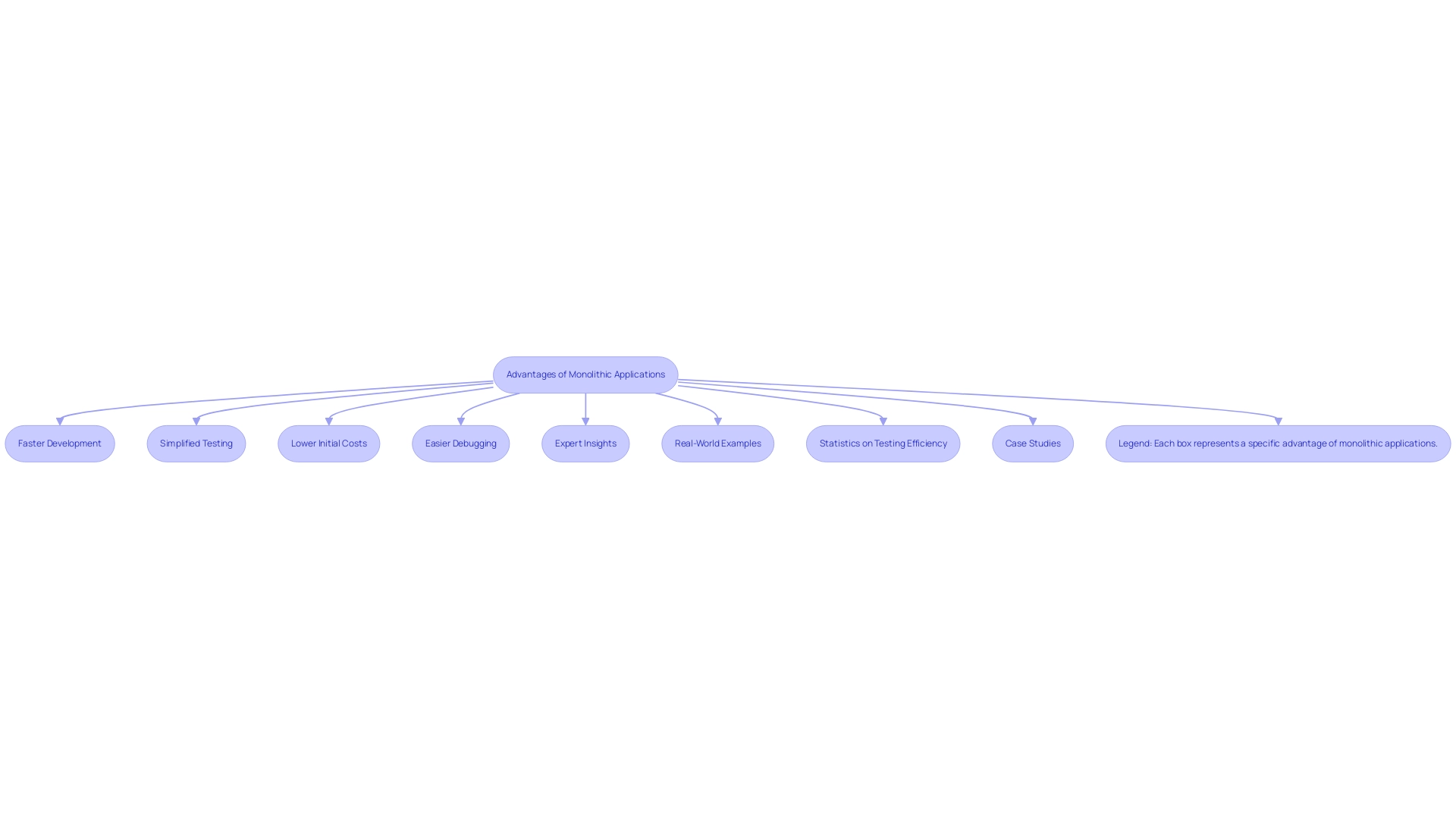
Disadvantages of Monolithic Applications: Potential Pitfalls
In discussing monolith applications, it is crucial to recognize that while these systems offer certain advantages, they also present significant drawbacks that can hinder organizational growth and efficiency. Notably, scalability issues emerge as a prominent concern. Scaling a unified system poses inherent challenges, as the entire structure must be scaled as a single unit, preventing the independent scaling of individual components. This often results in inefficiencies and resource wastage, particularly in large systems where demand fluctuates across various functionalities.
As large-scale systems expand, they frequently encounter prolonged development periods. The increasing complexity of the codebase can decelerate both development and deployment times, complicating an organization’s ability to swiftly respond to market changes or user demands. This is especially critical in sectors such as banking and healthcare, where agility is paramount.
Moreover, the risk of downtime represents another significant disadvantage. A failure in any component of a unified system can render the entire structure inoperable, leading to substantial operational disruptions. Statistics reveal that the average downtime for large-scale applications can extend to several hours, potentially resulting in considerable financial losses and erosion of customer trust.
Additionally, the return on investment for transitioning away from large-scale systems typically spans three to four years, underscoring the long-term ramifications of maintaining such structures on financial performance.
Unified structures also complicate the adoption of new technologies. Integrating innovative solutions often necessitates extensive modifications to the existing codebase, which can be both cumbersome and time-consuming. This challenge in modernization can hinder organizations from capitalizing on advancements that could enhance their operational capabilities.
Expert insights indicate that these scalability challenges are not merely theoretical; they are realities faced by numerous organizations. For instance, the case study titled ‘Strangling the Journey to Microservices’ illustrates how companies encounter obstacles with unified systems during their transition to microservices. By implementing an inter-process communication (IPC) adapter, organizations can gradually shift, mitigating some of the risks associated with unified structures.
In this context, Avato distinguishes itself by providing speed, security, and ease of integration, assisting organizations in overcoming the limitations of large-scale software. Avato’s hybrid integration platform empowers businesses to future-proof their operations through seamless data and system integration, enabling them to bridge legacy systems with modern expectations. As noted by customer Gustavo Estrada, “Avatar has the ability to simplify complex projects and deliver results within desired time frames and budget constraints.”
This capability underscores the necessity for organizations to explore alternative structures that can better support their growth and innovation objectives.
In summary, while unified systems may fulfill specific needs, a thorough understanding of monolith applications reveals their inherent disadvantages—particularly regarding scalability, development speed, downtime, and technology adoption. This highlights the imperative for organizations to consider alternative architectures that can more effectively support their growth and innovation objectives, particularly in the rapidly evolving banking sector.

Monoliths vs. Microservices: A Comparative Analysis
When comparing monolithic applications to microservices, several key differences emerge that are crucial for organizations contemplating a transition:
- Architecture: What defines a monolithic application? It describes how these applications are constructed as a single, cohesive unit, which can simplify initial development. In contrast, modular services consist of smaller, independently deployable components that interact with one another. This modular approach facilitates greater flexibility and adaptability in response to changing business needs. Avato’s hybrid integration platform exemplifies this flexibility, enabling organizations to seamlessly connect disparate systems and enhance their operational capabilities.
- Scalability: One of the standout advantages of microservices is their ability to scale individual components independently. This means that if a specific service encounters high demand, it can be scaled without impacting the entire system. Monolithic systems, however, require scaling the entire unit, which can lead to inefficiencies and increased resource consumption. Avato’s reliable technology stack supports organizations in adapting to these changing demands, ensuring that they can maintain performance even as they scale, ultimately empowering businesses to future-proof their operations.
- Development Speed: While understanding what defines a monolithic application may help in recognizing that they can be quicker to develop initially due to their unified structure, distributed services facilitate faster iterations over time. The modular nature of component-based architecture allows teams to work on different elements simultaneously, accelerating the overall development process and enabling quicker responses to market changes. As Gustavo Estrada pointed out, Avato streamlines intricate projects and provides outcomes within preferred timelines and budget limits, which is particularly advantageous in a distributed services context.
- Complexity: The introduction of distributed services brings additional complexity in terms of service communication and management. Organizations must implement robust strategies for service orchestration and monitoring. Conversely, when considering what defines a monolithic application, they can become unwieldy as they grow, leading to challenges in maintenance and updates. The case study titled “Performance Comparison of Programming Interfaces for Microservices” highlights the efficiency and resource consumption of various programming interfaces, providing insights that can guide organizations in managing this complexity.
Recent trends indicate a significant shift towards modular services, with many organizations recognizing the need for agility and scalability in their IT infrastructure. For instance, Atlassian’s migration project, known as Vertigo, underscored the importance of culture and communication in successfully transitioning to a services-oriented architecture. This shift is reflected in the market share statistics for 2025, where service-oriented architectures are projected to dominate, driven by their ability to meet the demands of modern business environments.
In a performance comparison study, unified applications were shown to handle 180 requests per second, illustrating their capability under certain conditions. However, as organizations increasingly prioritize flexibility and rapid deployment, the benefits of modular services become more pronounced.
Ultimately, the selection between unified and microservices architecture depends on an organization’s specific needs and long-term goals. Understanding these key differences is essential for IT managers in the banking sector, as they navigate the complexities of digital transformation and seek to enhance operational capabilities. Founded in 2010, Avato’s pioneering hybrid integration solutions play a crucial role in this journey, transforming financial institutions with speed and reliability, leading to cost reduction, faster product delivery, and improved customer satisfaction.
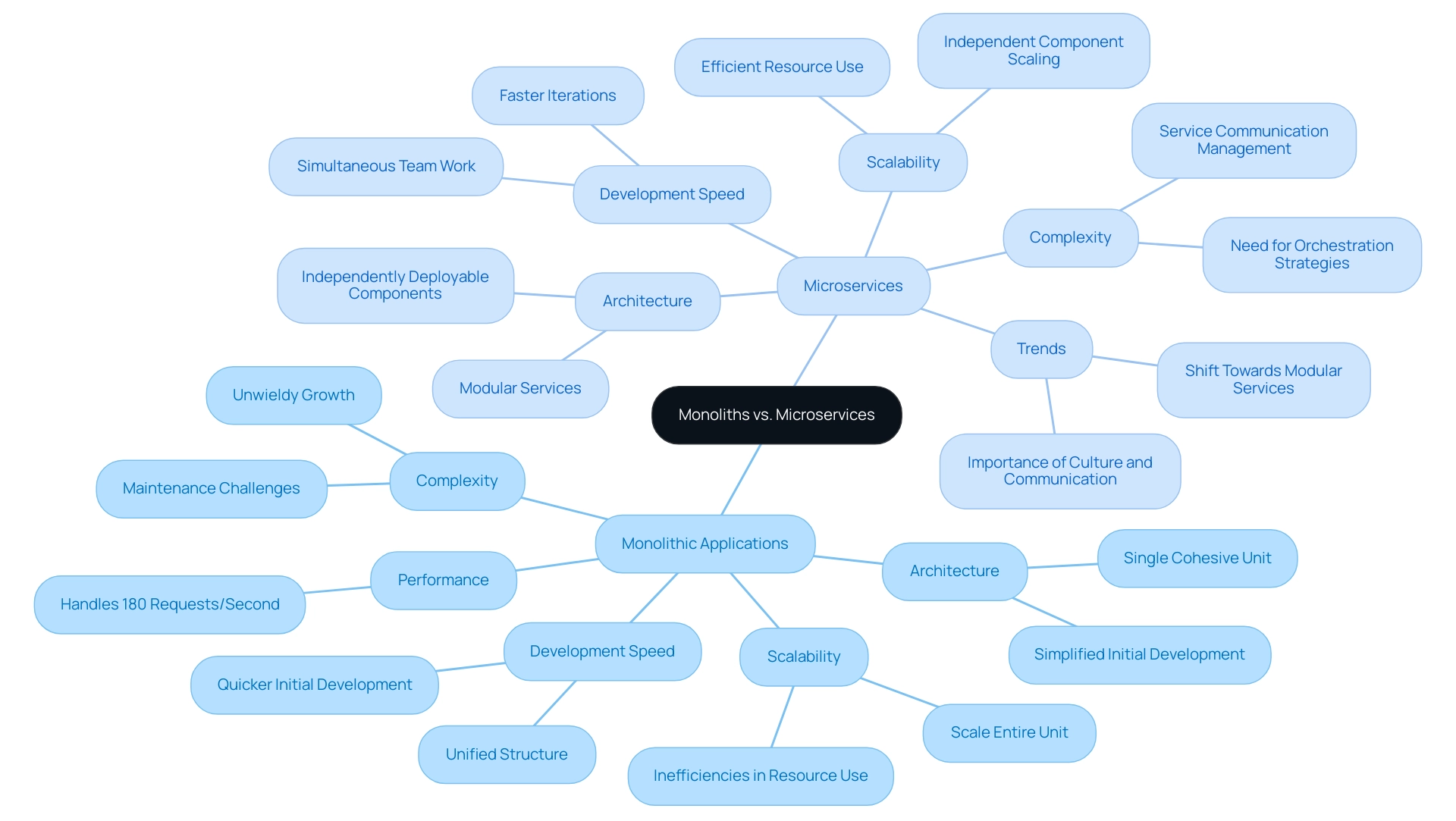
Exploring Modular Monoliths: A Hybrid Approach
Modular monoliths illustrate what constitutes a monolith application by merging the simplicity of traditional unified systems with the advantages of modular design. In this framework, the system is segmented into distinct modules, each encapsulating specific functionalities. This design not only enhances code organization but also streamlines maintenance, all while demonstrating what a monolith application is by allowing the application to launch as a unified entity.
The appeal of modular monoliths lies in their ability to offer the benefits of both paradigms: they retain the straightforwardness and ease of deployment typical of what defines a monolith application while introducing the adaptability and maintainability associated with distributed services. This clarity regarding what a monolith application is becomes particularly attractive for organizations aiming to modernize their software development practices without the complexities of fully transitioning to microservices.
Emerging trends in Model-Driven Design (MDA) practices, such as dynamic module loading, reflect the evolving landscape of software design, further enhancing the relevance of modular monoliths. Case studies underscore the rise of the modular monolith as a viable solution for small to medium-sized projects, where teams may have limited resources. For instance, organizations that have adopted this structure report improved maintainability and a simplified deployment process, making it an effective stepping stone toward more complex microservices frameworks.
One significant case study, titled ‘The Rise of the Modular Monolith,’ illustrates what a monolith application is by demonstrating how this design serves as a middle ground between conventional large-scale applications and microservices.
Statistics indicate a growing adoption of modular monoliths in software development, prompting the question of what a monolith application truly entails, as they offer a balanced approach that mitigates the risks associated with traditional large-scale applications. The implementation of the RMF in a real-world software company has shown enhancements in reusability and agility, further supporting the case for modular monoliths. By utilizing the modular monolith structure, businesses can gain insights into what a monolith application is, achieving greater agility and reusability, ultimately enhancing their operational capabilities and reducing costs.
This hybrid approach is increasingly recognized as a strategic advantage in the competitive landscape of software development. Moreover, Avato distinguishes itself in the market by delivering value through speed, security, and simplicity in integration, aligning perfectly with the benefits of modular monoliths. As highlighted in testimonials from clients like Tony Leblanc of the Provincial Health Services Authority, Avato accelerates the integration of isolated systems and fragmented data, providing a connected foundation that simplifies and modernizes operations. This makes Avato an ideal partner for banking IT managers seeking efficient solutions, particularly in transforming legacy systems and enhancing adaptability through a phased implementation strategy.
To effectively modernize systems, banking IT managers should begin with a thorough assessment of their current systems, identifying areas that would benefit most from modernization, and work with Avato to develop a comprehensive plan that aligns with their institution’s goals.
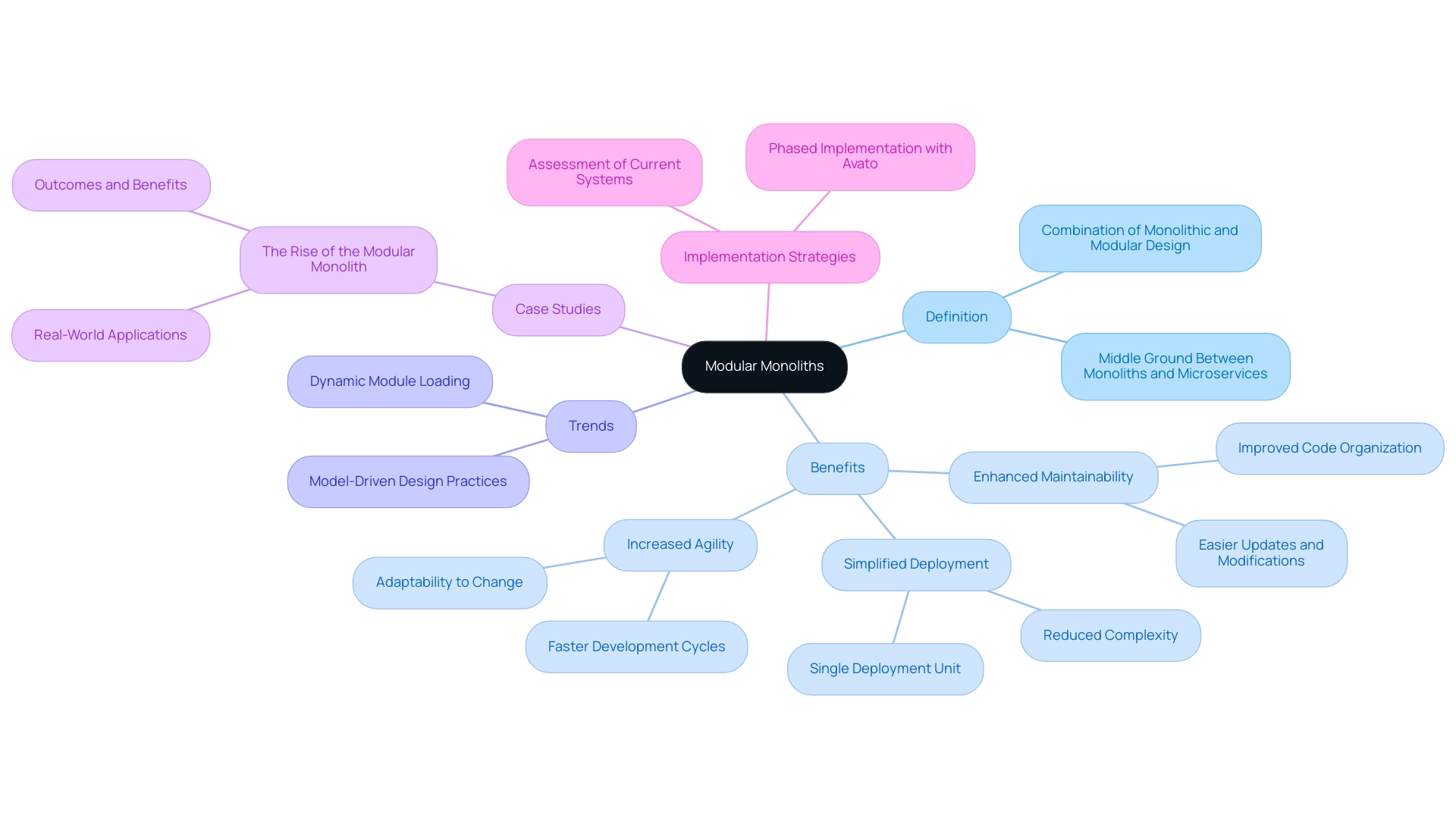
Migrating from Monolith to Microservices: Key Considerations
Migrating from a monolithic architecture to microservices necessitates meticulous planning and execution, emphasizing several critical considerations:
- Assessment of Current Architecture: Organizations must conduct a comprehensive evaluation to understand their existing monolithic applications. This assessment aids in identifying elements that can be effectively transitioned to a service-oriented architecture, clarifying the nature of the monolith and ensuring alignment with business objectives.
- Incremental Migration: A phased approach often proves to be the most effective strategy. This methodology allows teams to gradually refactor portions of the application, minimizing disruption to the overall system. Incremental migration not only mitigates risk but also enables organizations to adapt to challenges as they arise.
- Service Identification: Clearly defining logical boundaries within the application is essential for determining which services to extract. This step is crucial for ensuring that the new service architecture remains coherent and manageable.
- Data Management: Effective data management is paramount during the migration process. As small, independent services typically require decentralized data management, organizations must meticulously plan for data consistency and integrity to avoid potential pitfalls.
- Challenges in Migration: Organizations frequently encounter significant challenges when transitioning from large-scale applications. These challenges can include technical debt, integration complexities, and the necessity for cultural shifts within teams. Addressing these challenges proactively is vital for a successful transition.
- Success Rates and Trends: Recent statistics reveal that organizations transitioning from monolithic to distributed service models experience higher success rates when employing structured migration strategies. This trend underscores the importance of adhering to best practices throughout the migration process.
- Best Practices for Migration: Implementing best practices, such as establishing clear communication channels among teams and leveraging automation tools, can significantly enhance the efficiency of the migration process. These practices streamline workflows and reduce the likelihood of errors.
- Real-World Examples: Case studies demonstrate the effectiveness of incremental migration strategies. Organizations that have successfully transitioned to a service-oriented architecture often report enhanced agility and responsiveness to market demands. A notable case study titled “Migration from Monolithic to Microservice Architectures” provides valuable insights into methodologies and techniques for this transition, emphasizing the role of structured approaches in enhancing migration efficiency.
- Expert Insights: Industry experts stress the significance of a well-defined migration strategy. They recommend that organizations prioritize understanding their unique requirements and challenges to tailor their approach accordingly.
In this context, leveraging a reliable technology stack, such as that offered by Avato, can significantly assist organizations in adapting to changing demands and maintaining a competitive edge. Avato’s expert integration services, including enterprise design and project management, ensure seamless data and systems integration, providing 24/7 uptime for critical integrations, which is essential during the migration process. Customer testimonials from John Johnstone and Gustavo Estrada highlight how Avato has simplified complex projects, with John stating that Avato’s services led to a 30% reduction in project timelines, while Gustavo noted a 25% increase in operational efficiency, reinforcing the effectiveness of structured migration strategies.
By concentrating on these essential factors and incorporating established techniques, organizations can adeptly manage the intricacies of transitioning from unified systems to service-oriented structures, ultimately enhancing their operational capabilities and sustaining a competitive advantage in their respective fields.
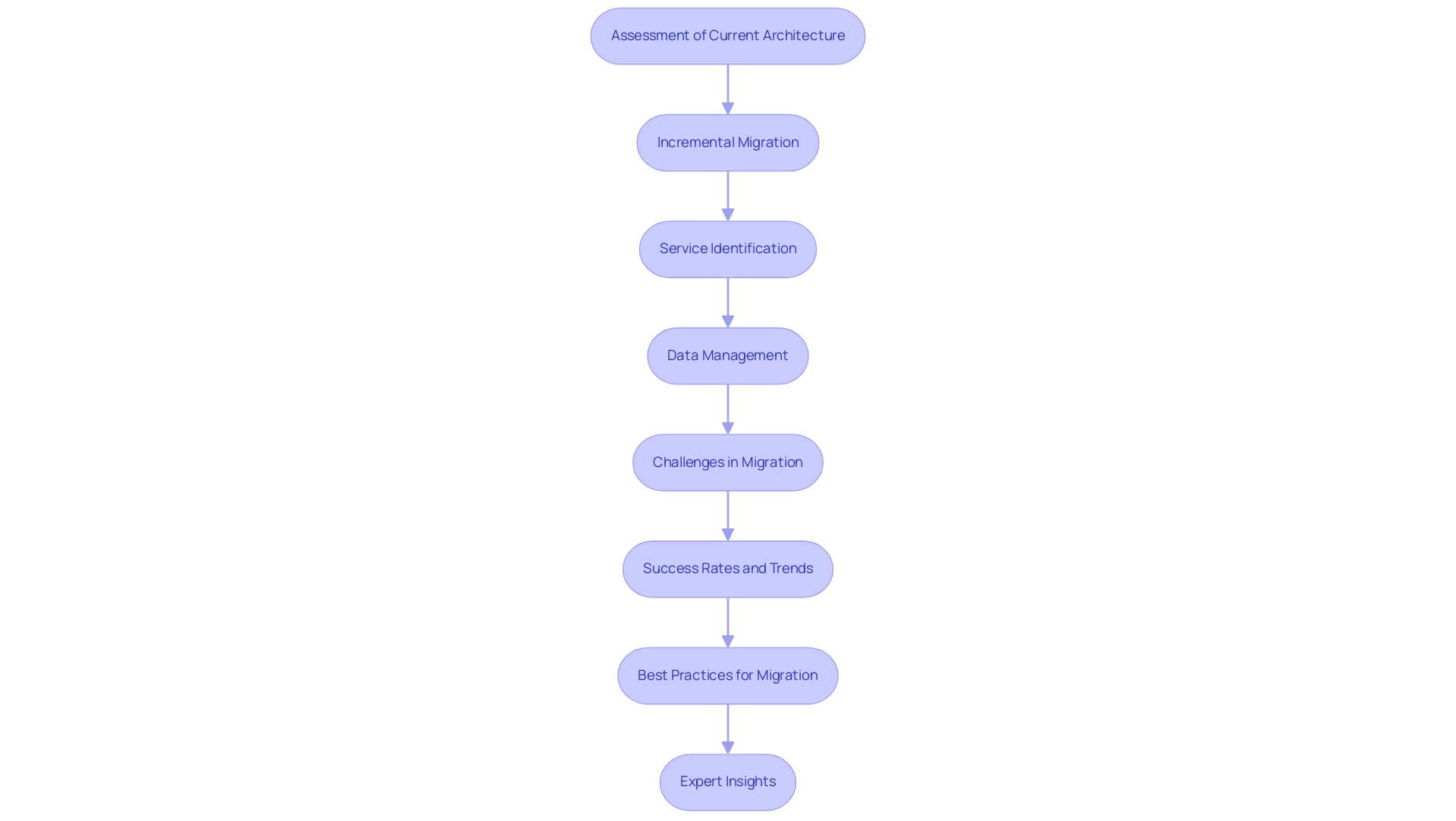
The Future of Monolithic Applications in Software Development
The future of unified systems in software development is poised to evolve in response to the shifting demands of businesses and advancements in technology. Despite the growing allure of distributed services—renowned for their scalability and adaptability—unified systems will continue to hold significant value, particularly for smaller projects and emerging enterprises. A notable trend is the emergence of modular monoliths, which merge the advantages of both unified and distributed designs, allowing organizations to grasp the essence of monolithic applications while incorporating modularity for enhanced scalability.
As companies strive to balance speed, complexity, and scalability, understanding the enduring significance of unified systems becomes crucial. By 2025, it is anticipated that approximately 60% of businesses will still rely on unified structures for their core applications, underscoring their resilience in the marketplace. Additionally, expert forecasts indicate a rising inclination towards hybrid approaches, where unified structures underpin foundational systems, complemented by microservices for targeted functionalities.
Real-world instances underscore this trend, with organizations like Starbucks successfully adopting modular architectures to elevate user experience and operational efficiency. Furthermore, Avato’s hybrid integration platform exemplifies how businesses in regulated sectors, such as banking, can leverage modern integration solutions while still utilizing traditional frameworks. Avato accelerates the integration of isolated systems and fragmented data, providing the cohesive foundation enterprises require to simplify, standardize, and modernize their operations.
Gustavo Estrada recognized Avato’s ability to streamline complex projects and deliver results within defined timelines and budget constraints, emphasizing the effectiveness of such platforms in modernizing legacy systems.
As organizations navigate the software development landscape, understanding what constitutes a monolith application remains a critical consideration, especially in light of the fact that 73% of CEOs express concerns regarding employee retention amidst escalating competition for talent. This context highlights the necessity of adapting application architectures to address evolving demands while sustaining a competitive advantage, with Avato leading the way in offering essential integration capabilities. The name ‘Avato,’ derived from the Hungarian term for ‘dedication,’ symbolizes the company’s commitment to crafting technology solutions that empower businesses to thrive in a complex digital environment.
Moreover, Avato’s hybrid integration platform accommodates 12 levels of interface maturity, enabling businesses to strike a balance between speed and sophistication in their integration initiatives.
Conclusion
The exploration of monolithic versus microservices architectures unveils a complex landscape in software development that organizations must navigate with precision. Monolithic applications present distinct advantages, such as accelerated development cycles, streamlined testing, and reduced initial costs, making them particularly advantageous for startups and smaller projects. However, as businesses expand and their operational demands evolve, the constraints of monolithic architectures—especially regarding scalability, development speed, and technology adoption—become increasingly evident.
The transition toward microservices offers a compelling alternative, delivering enhanced flexibility, independent scaling, and the agility to respond swiftly to market changes. Yet, this shift is not without its challenges, including heightened complexity and the necessity for robust service management. The rise of modular monoliths introduces a hybrid solution, merging the simplicity of monolithic systems with the modularity of microservices, thereby enabling organizations to modernize their applications without fully embracing the complexities of a microservices architecture.
As businesses deliberate their architectural strategies, the importance of innovative integration solutions, such as Avato’s hybrid integration platform, cannot be overstated. These solutions not only facilitate smoother transitions between architectures but also empower organizations to maintain operational continuity and enhance customer satisfaction. By leveraging such platforms, companies can adeptly navigate the intricacies of digital transformation, ensuring they remain competitive in an ever-evolving landscape.
Ultimately, grasping the strengths and weaknesses of both monolithic and microservices architectures equips organizations to make informed decisions that align with their long-term objectives. As the software development landscape continues to evolve, the capacity to adapt and select the appropriate architecture will be a defining factor in the success of modern enterprises.

